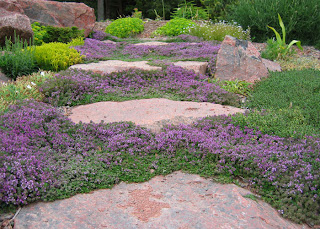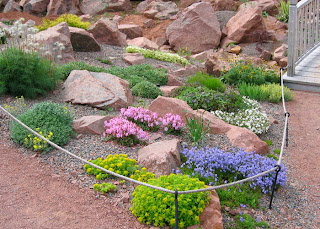
One of these years I hope to have a thyme walkway, but in the meantime, I'll enjoy the one that wends through the Rock Garden.

Trough gardens are something I'm just starting to get into. I love the delicate textures and colours of the plants, although this platycodon isn't what you'd call subtle, is it?

I do not know what sedum this is. I intend to find out and get one for our garden. The foliage colours are subtle, moreso than some of the purple or variegated ones, and the flowers I would call soft yellow--as opposed to the usual brilliant yellow of some of the creeping types, or the flaming hot pink of some of the tall species and cultivars. Whatever it is, I WANT!

I can't find in my notes just how many tons of rock were brought in to create the topography of the rock garden, but it was an impressive amount. This was always a hillside, sloping down from some of the campus classroom and admin buildings towards the farm, but it was grassed with some trees and shrubs and a few plots of annuals in my day. This has all been built in less than five years, too!

There is always something in bloom throughout the gardening months, that's for sure! I love the rich colours of the dianthus and veronicas.

This courtyard features a number of trough gardens, a crevasse garden, a lovely pergola and places to sit and dream.

Taken earlier in the season, with lots of brilliant colour and texture among the boulders and pea gravel.

Matching planters grace the entryway to Cumming Hall, the administration building and home to Alumni Theatre. I spent a lot of time in this building back in my day, studying in empty classrooms or looking at the class portraits from graduating classes of years gone by.

This dish garden of succulents stopped me dead in my tracks when I saw it, and an instant flush of plant-lust came over me. Succulents really appeal because of their unique shapes, colourations and just tidy ways of growing. I have to confess that mine have suffered over the past few months, through benign neglect--but I will make amends!

If memory serves correctly, this is an Echeveria species in flower. I love the subtle colours around the flowers, don't you?

This might be a naughty species of ladybird beetle. I don't know--but I got a great charge out of watching it delicately nibbling the edge of a leaf.

If I'd been thinking, I would have set something down beside this plant to show the size of its leaves, which are, in a word, minute; each leaf is about the size of the head of a pin. In fact, my first look at this dish garden I didn't even notice this succulent, and if you go back and look at the photo of the whole dishgarden you'll see why. And if you click on this one to enlarge, you'll see an oxalis leaf among the plant, so that gives you some scale too.
And this entry shows just one more reason why I love plants--the huge variation in colours, forms, textures, sizes, etc just keeps me appreciating, and learning, more about these marvelous organisms. I hope you enjoyed this little trip to the Rock Garden too!
















































